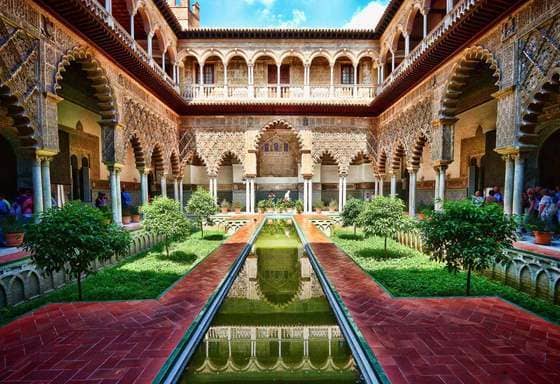The manifestations of Islamic architecture in Andalusia,
After the Muslims completed the liberation of Andalusia,
they began to implement their humanitarian message in civilization,
as they were able in less than a century to revive the lands of Spain.
They began by reconstructing ruined cities and erecting the most luxurious buildings,
as well as establishing close commercial contacts with other countries.
Then they began studying science and literature, translating Greek and Latin books,
and establishing universities, which alone remained a refuge for culture in Europe for a long time.
The Arab civilization began to rise in Andalusia since the accession of “Abd al-Rahman I” to the throne,
that is, since its political separation from the East by the declaration of the Emirate of Cordoba in the year 138 AH / 756 AD.
Andalusia became the world’s most civilized country for three centuries.
The country was flourishing according to times of strength and weakness,
and according to its rulers and the nature of their whims.

The manifestations of Islamic architecture in Andalusia
Some of them loved fighting and jihad in the cause of God,
and some of them loved luxury and good looks more than necessary.
Abd al-Rahman al-Dakhil, since his rule in Andalusia, was interested in organizing Cordoba to match the greatness of the state,
so he renewed its meanings, tightened its buildings and fortified it with walls.
The Emirate Palace, the mosque and its courtyard were expanded,
then the city of Rusafa was built according to the art of Islamic architecture in the Levant,
whether in its architectural decorations or in some elements of its construction,
and in the system of its contracts.
Abd al-Rahman I also built the Rusafa Palace and transferred to his city the oddities of the Persians and Akram fruits,
which spread to all parts of Andalusia.
The Great Mosque of Cordoba was very grand in its construction and engineering,
and it became the greatest Arab university in Europe in the Middle Ages.
Andalusia was famous for its great architectural structures.
The Lighthouse of Seville, the “air game” built by the Almohads in the sixth century AH / 12th century AD,
and the Seville Palace are among the effects of the mediating role of Arab architecture.
The Alhambra Palace in Granada, which was built in the eighth century AH / fourteenth century AD, is a title for what the Arab architecture ended with,
and thus the most important aspects of Islamic architecture in Andalusia were mentioned.
The evolution of Andalusian architecture over time
It is known that many peoples inhabited Spain in general and all contributed to the development of the arts in it,
but the Arab-Islamic influence, specifically, Islamic architecture in Andalusia (Iberia Peninsula),
especially in its southern and southwestern sections, remains the most important and enduring.
This is due to the large number of buildings in which they remained witness to the intellectual and artistic renaissance
that the Umayyad Caliphate and the various Arab emirates knew in Andalusia from the second century until the ninth century AH / eighth until the fifteenth century AD.
And the extension of Arab artistic influences to the rest of the regions of Spain that remained in the hands of the Spaniards
or recovered them until the end of the rule of Arabs and Muslims from it.

Arab architecture in Andalusia during the Arab Islamic rule
The era of the Arab rule of Andalusia was a period of important civilized development.
Arab civilization reached that country with its Arab-Islamic characteristics that had begun to crystallize in the Levant during the Umayyad rule.
The Arabs brought their way of life to Andalusia and adapted it according to the conditions of life in Andalusia,
such as the dwelling open to the inner courtyard decorated with gardens and water surfaces.
They also developed ways of farming and irrigating the land until prosperity spread to the cities and the countryside.
The cities in which they resided were organized according to the oriental style,
with narrow streets with broken axes to ward off the sun and protect the population.
Gold was used for downloading and decorating, so the doors of mosques and palaces and pieces of furniture were painted over with it.
The industry of downloading gold threads on tin, copper and lead is still present today in Toledo and other Spanish cities.
You may like: Modern architecture in Saudi Arabia

